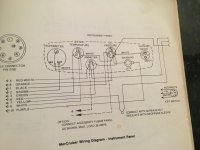Assuming the points are good, with the points open, you will measure full battery voltage on the coil + wire due to there being no current dropping the voltage through the ballast resistor/wire.
With the points closed, you will see the battery voltage minus the voltage drop across the ballast device.
With the engine running, due to the points opening and closing, you'll see some amount of voltage greater than what you'd see with them closed and the engine stopped. That amount will depend on the duty cycle of the points (dwell) and the condition of the condenser. More dwell will show a lower voltage here and less dwell will show a higher voltage because the higher the dwell angle (the smaller the points gap), the longer the points are closed.
Put your meter across the ballast device, set it to AC reading, and if you see a few volts while it's running, the ballast device is doing it's job.




















